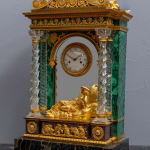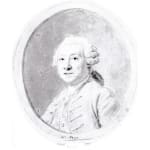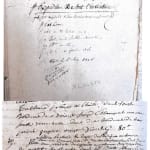
Jean-Baptiste Magon de Ia Balue (1713-1794). Charcoal drawing, circa 1775 Paris, Musée du Louvre

Pages from the probate inventory of Jean-Baptiste Magon de la Balue
Lepaute
Further images
Provenance
- Confiscated during the Revolution from Jean-Baptiste Magon de La Balue, Former- General and banker to the Comte d'Artois (the brother of King Louis XVI) and to the French Court
- Consigned to the Dépôt de Physique of the Louvre (today the Louvre Museum).
- Inventoried in 1795 after the death of Magon de la Balue in the salon of his home atPlace Vendôme, Paris; subsequently returned to his heirs and to the family home.
- Sold Chartres, Maître Lelièvre, auctioneer.
- Formerly in the collection of Marc Revillon d'Apreval, Paris.
- Important private collection, Paris.
Literature
- Tardy La pendule française dans le Monde, Paris, 6th edition, 1994, p.312 (illustration).
- Pierre Kjellberg Encyclopédie de la pendule française du Moyen Age à nos jours, Les éditions de l'Amateur, Paris, 1997,p.454, fig. B (illustration).
- Elke Niehüser, Die französische Bronzeuhr, Eine Typologie der figürlichen Darstellungen, Munich, 1997, p. 254, fig. 1120 (illustration)
The round enamel dial, signed "Le Paute Hger du Roy", indicates the Roman numeral hours and the Arabic numeral five-minute intervals by means of two pierced gilt bronze hands. A central blued-steel hand indicates the seconds. The bezel is adorned with an egg-and-dart frieze framed by a beaded border; it is set against an arched, mirrored ground. The movement, with compensated bimetallic balance, knife-edge suspension and a pinwheel escapement, strikes the hours and half hours. The case, in the form of an antique portal, is made of portor marble, red Egyptian porphyryr, malachite, rock crystal, and finely chased gilt bronze. The pediment, adorned with curved motifs with palmettes, scrolling and rosettes, surmounts a classical entablature with acanthus leaf, egg-and- dart and palmette friezes. The main portion of the case features applied half columns and two spirally-ornamented columns with composite capitals, framing the three- dimensional sculpture of a reclining goddess, inspired by an antique marble sculpture today in the Vatican Museum in Rome. The plinth and the columns rest upon bases adorned with leaf friezes, the faqade is adorned with lions' masks framed by ribbon-tied branches and scenes depicting six rats, two of which are fighting over a bell. The clock rests on a quadrangular base that is raised upon four flattened bun feet.
This highly unusual clock has an exceptional provenance. It was described with great precision in the probate inventory of banker Jean-Baptiste Magon de La Balue that was drawn up on 9 fructidor in the year III (August 26, 1795). The clock was among the objects seized from the banker's home during the Revolution: "the effects taken by citizen Lepicard by virtue of the powers bestowed upon him, from the national repository, designated below, which were offered at auction on the 15th of this month, and which, after verification by the afore-mentioned citizen and justice of the peace, were again placed under seal. The item number 207 in the inventory which was among the "effects taken from the Dépôt de Physique in the Louvre" was described as follows:
"Item a clock by Lepaute with columns and chapters of rock crystal, in a case veneered in malachite the base made of portor marble with a red porphyry base, in the middle there is a blue porcelain cat placed on a gilt bronze cushion, with a decorative frieze and half- seconds verge escapement, estimated six thousand livres 6000#' (Archives nationales, Minutier Central des notaires, ET/MC/XLll/684).
The document indicates that the clock was the only precious object remaining "in the salon overlooking the Place Vendôme"; and that it was therefore returned to Magon's heirs.
The estimation of 6000 livres, an extraordinary sum for the time, is equivalent to that of a painting by Rembrandt. The extremely fragile blue porcelain cat was replaced during the early 19th century by a superbly executed depiction after the antique of the sleeping Cleopatra, which is in harmony with the rest of the composition. The clock, whose design is impressively avant-garde, features certain gilt bronze motifs that would not become part of the decorative vocabulary until the Empire period, a decade later, when they were employed in some of the most important pieces of the time. The clock features rock crystal, an extremely sought-after material, marble, rare and precious stones including red Egyptian porphyry, portor marble and malachite, and exceptionally well-executed gilt bronze mounts, supporting the attribution to the Parisian chaser-gilder François Rémond. The present clock, a one-of-a-kind piece that was commissioned by one of the most important collectors of the time, is unquestionably one of the masterpieces of the French decorative arts of the second half of the 18th century.
Jean-Baptiste Magon de Ia Balue (Saint-Malo 1713-Paris 1794)
was one of the most influential figures in finance and banking during the reign of Louis XVI. He came from a family of wealthy ship owners from Saint Malo, and took advantage of the fall from grace of the duc de Choiseul (former Minister of Foreign Affairs and the Navy) and of Jean-]oseph de Laborde, banker to Louis XVI, to become the sole banker to the French Court. His bank was located in the Place Vendôme, and he himself was known respectfully as "Monsieur Magon“. Within just a few years he had amassed a considerable fortune, ranking him as one of the wealthiest people in France. During the French Revolution his past as a former Farmer-General close to the king led to his arrest, imprisonment and execution on July 19,1794.
Lepaute Horloger du Roi à Paris
This is the signature of the brothers Jean-André Lepaute (1720-1789) and Jean-Baptiste Lepaute (1727-1802), remarkable clockmakers born in Thonne-la-Long in Lorraine who were both horlogers du Roi.
Jean-André came to Paris as a young man and was joined by his brother in 1747. The Lepaute enterprise founded informally in 1750, was formally incorporated in 1758. ]ean-André, who was received as a maître by the corporation des horlogers in 1759, was lodged first in the Palais du Luxembourg and then, in 1756, in the Galeries du Louvre.
Jean-André Lepaute wrote a horological treatise (Traité d'Horlogerie), published in Paris in 1755. Another volume, entitled Description de plusieurs ouvrages d'horlogerie (A Description of several horological pieces) appeared in 1764.
In 1748 he married the mathematician and astronomer Nicole-Reine Etable de Ia Brière, who among other things predicted the return of Halley's Comet.
Jean-Baptiste Lepaute received maître in December 1776, was known for the equation of time clock he constructed for the Paris Hôtel de Ville (1780, destroyed in the fire of 1871) and the clock of the Hôtel des Invalides.
The two brothers worked for the French Garde-Meuble de la Couronne; their clocks were appreciated by the most important connoisseurs of the time, both in France and abroad, such as the Prince Charles de Lorraine and the Queen Louise-Ulrika of Sweden.
Jean-Baptiste took over the workshop when Jean-André retired in 1775.
François Rémond (circa 1747-1812)
Along with Pierre Gouthière, he was one of the most important Parisian chaser-gilders of the last third of the 18th century. He began his apprenticeship in 1763 and became a master chaser-gilder in 1774. His great talent quickly won him a wealthy clientele, including certain members of the Court. Through the marchand-mercier Dominique Daguerre, François Rémond was involved in furnishing the homes of most of the important collectors of the late 18th century, supplying them with exceptional clock cases, firedogs, and candelabra. These elegant and innovative pieces greatly contributed to his fame.



